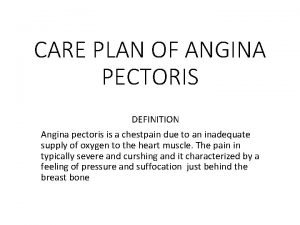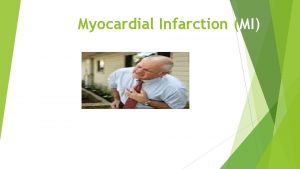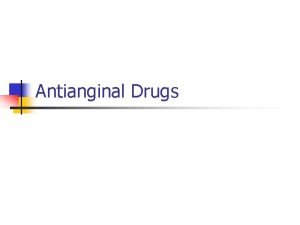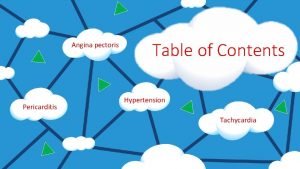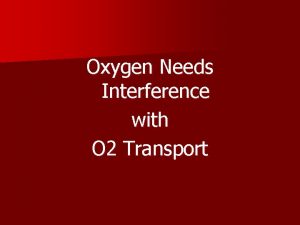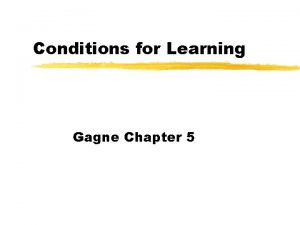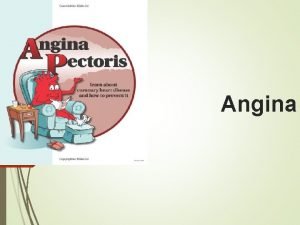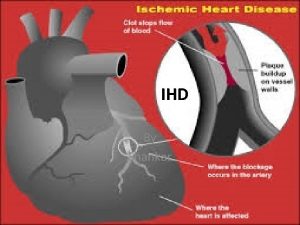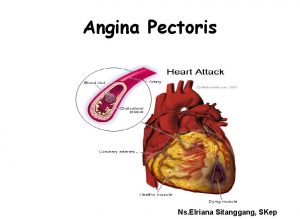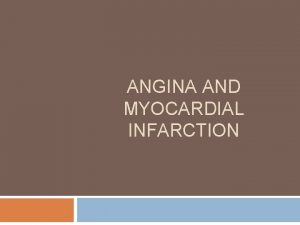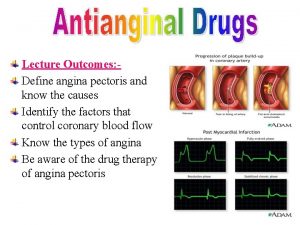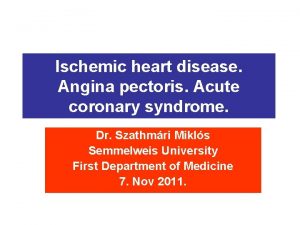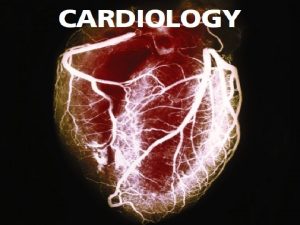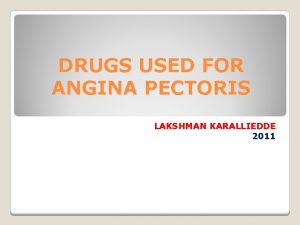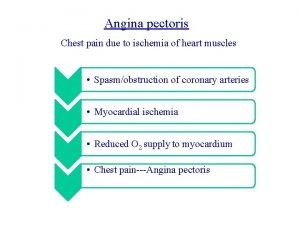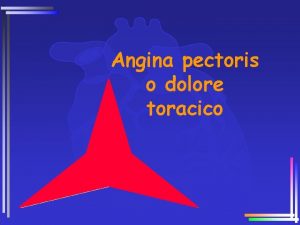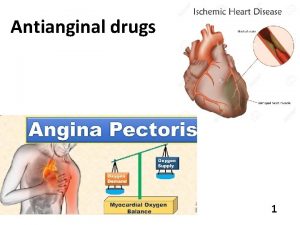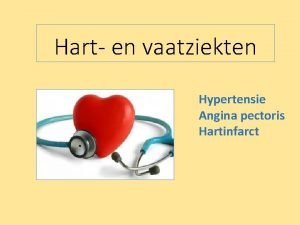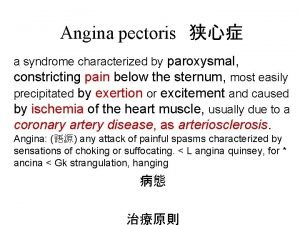Angina Angina pectoris learning outcomes On completion of





























- Slides: 29

Angina

Angina pectoris : learning outcomes On completion of this lecture the students will be able to : § Define angina pectoris § Describe the pathophysiology of angina § Recognize the clinical manifestations of angina § Predict the diagnostic findings of angina § Describe the medical treatment of angina § Apply a comprehensive nursing care plan to manage angina symptoms § Evaluate the patient’s condition after receiving the required care and treatment

Out lines Definition of angina Pathophysiology of angina Factors affecting angina pain Classification of severity of angina pain according to Canadian Cardiovascular Society Types of angina Medical management Nursing management

Angina pectoris is a clinical syndrome usually characterized by episodes or paroxysms of pain or pressure in the anterior chest. The cause is usually insufficient coronary blood flow. The insufficient flow results in a decreased oxygen supply to meet an increased myocardial demand for oxygen in response to physical exertion or emotional stress. In other words, the need for oxygen exceeds the supply. The severity of angina is based on the precipitating activity and its effect on the activities of daily living

Pathophysiology of angina Angina is usually a result of atherosclerotic heart disease and is associated with a significant obstruction of a major coronary artery. Normally , the myocardium extracts a large amount of oxygen from the coronary circulation When there is a blockage in a coronary artery , flow can’t be increased to meet an increased myocardial demands and the resulting ischemia cause anginal pain



Factors affecting anginal pain Physical exertion Exposure to cold Eating a heavy meal Stress or any emotion – provoking situation that increases blood pressure , heart rate , and myocardial workload


Types of angina Stable angina: predictable and consistent pain that occurs on exertion and is relieved by rest Stable angina is usually triggered by physical exertion. When the patient climb stairs, exercise or walk, the heart demands more blood, but it's harder for the muscle to get enough blood when the arteries are narrowed. Besides physical activity, other factors, such as emotional stress, cold temperatures, heavy meals and smoking, also can narrow arteries and trigger angina.

Unstable angina (also called preinfarction angina or crescendo angina): symptoms occur more frequently and last longer than stable angina. The threshold for pain is lower, and pain may occur at rest.

Unstable angina can also be caused by blood clots that block or partially block heart's blood vessels. It worsens and is not relieved by rest or usual medications. If the blood flow doesn't improve, heart muscle will be deprived of oxygen and heart attack developed. It is dangerous and requires emergency treatment.

Silent ischemia: objective evidence of ischemia (such as electrocardiographic changes with a stress test), but patient reports no symptoms •

Clinical Manifestations Pain varies from a feeling of mild indigestion to choking or heavy sensation in the upper chest. Severity can range from discomfort to agonizing pain Pain may be accompanied by severe apprehension and feeling of impending death Discomfort is poorly localized and may radiate to the neck , jaw , shoulders and inner aspect of the upper arms( usually the left )

Clinical Manifestations A feeling of weakness or numbness in the arms , wrists , and hands. Shortness of breathing , pallor , diaphoresis Dizziness , nausea and vomiting. An important characteristics of anginal pain is that it subsided when the precipitating cause is removed or with nitroglycerine

Assessment & diagnostic findings Evaluation of clinical manifestations of pain and patient history 12 - lead - electrocardiogram (ECG ). The patient may undergo an exercise or pharmacologic stress test in which the heart is monitored by ECG, echocardiogram, or both Blood tests including cardiac biomarkers : C-reactive protein (CRP) is a marker for inflammation of vascular endothelium. High blood levels of CRP have been associated with increased coronary artery calcification and risk of an acute cardiovascular event Neuclear scan , or invasive procedure as cardiac catheterization and coronary angiography

Medical Management The objectives of the treatment are : ü Decrease the oxygen demands of the myocardium ü Increase the oxygen supply Pharmacological therapy : ü Nitrates (nitroglycerine )vasodilator ü Beta adrenergic blockers (tenormine , inderal) decrease the myocardial workload ü Calcium channel blockers (deltiazem) potent vasodilator ü Antiplatelet (aspirin ) ü Oxygen supplement

Nursing processes : Assessment : § Gather information about the patient’s symptoms and activities especially those the precede and precipitate attacks of angina pectoris § In addition , assess the patient’s risk factors for CAD, the patient’s response to angina , the patient’s and family’s understanding of the diagnosis , and adherence to the current treatment plan.

Assessment of anginal pain Action P Q R S Factors to be assessed Position/ location Where is the pain ? can you point it ? Provocation What are you doing when the pain began? Quality How would you describe the pain? Is it like the pain you had before? Quantity Has the pain become constant? Radiation Can you feel the pain anywhere else ? Relief Did any thing make the pain better? Severity How would you rate the pain on 0 -10 scale? Did you notice any other symptoms with the pain? Symptoms T Questions needed to assess Timing How long ago did the pain start ?

Nursing diagnosis : Based on the assessment data, major nursing diagnoses for the patient may include: Ineffective myocardial tissue perfusion secondary to CAD, as evidenced by chest pain or equivalent symptoms Anxiety R/T cardiac symptom and possible death Deficit knowledge R/T disease and methods for avoiding complications Noncompliance , ineffective management of therapeutic regimen related to failure to accept necessary lifestyle changes

Planning &Goals The major patient goals include: immediate and appropriate treatment when angina occurs, prevention of angina, reduction of anxiety, awareness of the disease process and understanding of the prescribed care, adherence to the self-care program, and absence of complications.

Nursing Interventions. Treating angina : . § Take immediate action if patient reports pain or prodromal symptoms suggestive of cardiac ischemia , including sensation of indigestion or nausea , chocking , heaviness , weakness or numbness in the upper extremities , dyspnea or dizziness. § Direct the patient to stop all activities and sit or rest in bed in a semi –fowler’s position to reduce the oxygen requirements of the ischemic myocardium § Measure V/S & observe for signs of respiratory distress

Nursing Interventions. Treating Angina. Obtain a 12 - lead ECG and place the patient on continuous cardiac monitor Administer nitroglycerine sublingually and assess the patient’s response (repeat up to 3 doses only ) O 2 therapy If the pain is continuous after these interventions , evaluate the patient further for acute MI

Nursing Intervention , Reducing Anxiety Explore implications that the diagnosis for the patient Provide essential information about the illness and methods of preventing progression Explain the importance of following the prescribed directive for the ambulatory patient at home Explore various stress reduction

Nursing intervention. Preventing pain Review the assessment findings , identify the level of activity that cause the patients pain If the patient has pain frequently or with minimal activity alternate the patient’s activities with rest periods balancing rest and activity in an important aspect of patient’s education

PROMOTING HOME AND COMMUNITYBASED CARE Teaching Patients Self-Care: . Learning about the modifiable risk factors that contribute to the continued development of CAD and resulting angina is essential. Exploring with the patient and family what they see as their priority in managing the disease and developing a plan based on their priorities can assist with patient adherence to therapeutic regimen Activities should be planned to minimize the occurrence of angina episodes The patient needs to understand that any pain unrelieved within 15 minutes by the usual methods should be treated at the closest emergency center; the patient should call 977 for assistance.

Self-Administration of Nitroglycerin Most patients with angina pectoris must self-administer nitroglycerin on an as-needed basis. A key nursing role in such cases is educating patients about the medication and how to take it. Sublingual nitroglycerin comes in tablet and spray forms. Teaching About Sublingual Nitroglycerin: • Instruct the patient to make sure the mouth is moist, the tongue is still, and saliva is not swallowed until the nitroglycerin tablet dissolves. If the pain is severe, the patient can crush the tablet between the teeth to hasten sublingual absorption. • Advise the patient to carry the medication at all times as a precaution. However, because nitroglycerin is very unstable, it should be carried securely in its original container (eg, capped dark glass bottle); tablets should never be removed and stored in metal or plastic pillboxes.

Teaching About Sublingual Nitroglycerin: • Explain that nitroglycerin is volatile and is inactivated by heat, moisture, air, light, and time. Instruct the patient to renew the nitroglycerin supply every 6 months. • Inform the patient that the medication should be taken in anticipation of any activity that may produce pain. Because nitroglycerin increases tolerance for exercise and stress when taken prophylactically (ie, before angina-producing activity, such as exercise, stair-climbing, or sexual intercourse), it is best taken before pain develops. • Recommend that the patient note how long it takes for the nitroglycerin to relieve the discomfort. Advise the patient that if pain persists after taking three sublingual tablets at 5 -minute intervals, emergency medical services should be called

Questions ? ? Thank you
 Nursing care plan on angina pectoris
Nursing care plan on angina pectoris Angina pathophysiology
Angina pathophysiology Angina pectoris
Angina pectoris Nitroglycerin srdce
Nitroglycerin srdce Stent placement
Stent placement Medici antiqui pectoris
Medici antiqui pectoris Medici antiqui pectoris
Medici antiqui pectoris Angian pectoris
Angian pectoris Erectus farmacia galeno
Erectus farmacia galeno Examples of learning outcomes
Examples of learning outcomes Learning outcomes of water cycle
Learning outcomes of water cycle Learning outcomes of notice writing
Learning outcomes of notice writing What is the objective of swot analysis
What is the objective of swot analysis Learning outcomes of rhymes
Learning outcomes of rhymes Example of learning objectives
Example of learning objectives What is photolysis in photosynthesis
What is photolysis in photosynthesis Photosynthesis learning objectives
Photosynthesis learning objectives Ncbts stands for
Ncbts stands for Objectives of linear equations in one variable
Objectives of linear equations in one variable Learning outcome generator
Learning outcome generator Direct and indirect speech objectives
Direct and indirect speech objectives Purpose of learning outcomes
Purpose of learning outcomes Output devices
Output devices Mri ib psychology
Mri ib psychology Reflective essay on learning outcomes
Reflective essay on learning outcomes Learning outcomes of holy week
Learning outcomes of holy week What is easter
What is easter Head start early learning outcomes framework
Head start early learning outcomes framework Learning objectives of fruits
Learning objectives of fruits Gagne's five categories of learning
Gagne's five categories of learning
